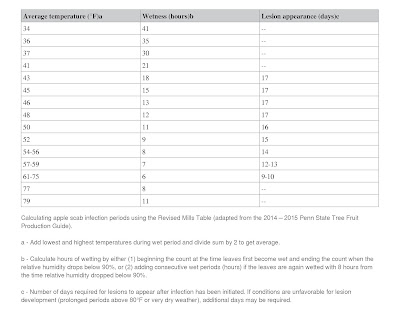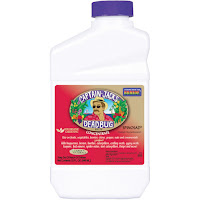 |
| Figure 1. |
Japanese Beetle emergence has begun here in Northern Illinois. I noticed the first beetles on Monday and today they were in full view on our Honeycrisp trees (Figure 1). Due to the large amount of carbohydrates produced by the Honeycrisp trees, which is what makes the variety so sweet, the Japanese Beetle is seemingly attracted to it just like we are! Honeycrisp seem to be the first leaves that attract them and then they move on to raspberries and several other berry varieties.
Monitoring for Japanese Beetle
Adult Japanese beetles emerge from the soil and live from 30 to 45 days feeding on plants over a four-to-six-week period. The adults produce aggregation pheromones that attract individuals (both
males and females) to the same feeding location. Adults can fly up to
five miles to locate a feeding site; however, they tend to fly only
short distances to feed and lay eggs. The adult beetles normally emerge during the last week of June through July. The first beetles out of the ground seek out that suitable food , like Honeycrisp, and begin to feed. These early arrivals then begin to release that aggregation pheromone (odor) that attracts additional adults. Newly emerged females also release a sex pheromone that attracts males. After feeding and mating for a day or two, the females burrow into the soil to lay eggs at a depth of 2 to 4 inches. Females lay 1 to 5 eggs before returning to plants to feed and mate. This cycle of feeding, mating and egg laying continues until the female has laid 40 to 60 eggs. Most of the eggs are laid by mid-August though adults may be found until the first frost. The eggs hatch in 8 to 14 days and the first instar larvae dig to the soil surface to feed on roots and organic material. The first instars shed their skin (molt) in 17 to 25 days. The second instars take 18 to 45 days to mature and molt again. Most of the grubs are in the third instar by late September and by October they dig deeper into the soil to overwinter. The grubs return to thesurface in the spring as the soil temperature warms, usually in mid-April. The grubs continue their development and form a pupa in an earthen cell 1 to 3 inches in the soil.
 |
| Figure 2. |
When you see those first few beetles, that is the time to begin you plan
of attack. Those first few beetles are the food source scouts that will
emit the aggregation pheromone letting other beetles know that a feast
is on! The Japanese beetle adults feed through the upper leaf surface
(epidermis)
and leaf center (mesophyll), leaving the lower epidermis intact. Adults
usually avoid feeding on tissue between leaf veins, resulting in leaves
appearing lace-like or skeletonized (Figure 2). Controlling those first few beetles can give you a head start on stopping the feeding/mating cycle.
Control for Japanese Beetle
There are some control options for the adult life stage One is physical removal and/or trapping of adults: Removing beetles by hand, or trapping, may provide adequate protection for small plantings when beetle numbers are low. However, Japanese beetle adults are capable of migrating from other areas, and the presence of beetles on or near a plant will attract more beetles. Consequently, use of Japanese beetle traps often attracts more beetles, and results in subsequent damage to plants.
 |
| Figure 3. |
The other alternative is chemical control of adults: Several insecticides are labeled for use against adult Japanese beetles. Always follow label directions. Treat foliage and flowers thoroughly. For optimal control, apply in the late afternoon when beetles are most active. Several
insecticides can be used for apple maggot control including those used
for codling moth and apple maggot control like acetmaprid. There are others like Sevin, but I do not recommend the use of Sevin since it is toxic to bees and to beneficial insects. Acetamiprid
is a soft, conventional control and is available as Ortho Flower, Fruit
& Vegetable Insect Killer (Figure 3). This is a ready to use product
that contains .006% acetamiprid, a synthetic organic compound of the
family of chemicals that acts as neonicotinoid insecticides. Acetamiprid
is a contact insecticide for sucking-type insects and can be applied as
a foliar spray or a soil treatment. When sprayed in the
evening at sunset, it will not harm bees or other beneficial insects.
If you do choose to use chemical controls make sure that the plant you are applying to is listed on the label as well as Japanese Beetles. If controlling Japanese Beetles on food crops such brambles or apples – make sure to follow the harvest-restriction date on the label. Always READ and FOLLOW the label and do not apply at rates higher than listed.
This publication contains pesticide recommendations that are subject to change at any time. These recommendations are provided only as a guide. It is always the pesticide applicator's responsibility, by law, to read and follow all current label directions for the specific pesticide being used. Due to constantly changing labels and product registration, some of the recommendations given in this writing may no longer be legal by the time you read them. If any information in these recommendations disagrees with the label, the recommendation must be disregarded. No endorsement is intended for products mentioned, nor is criticism meant for products not mentioned. The author assumes no liability resulting from the use of these recommendations.


































